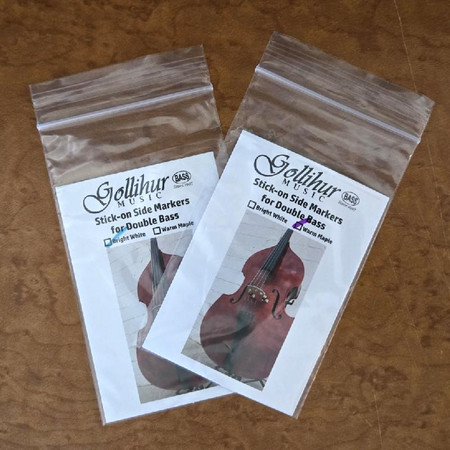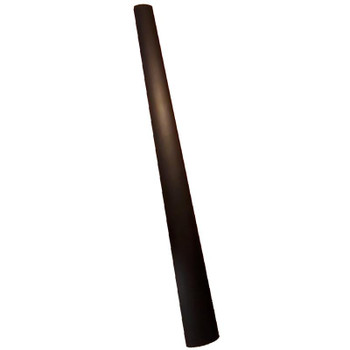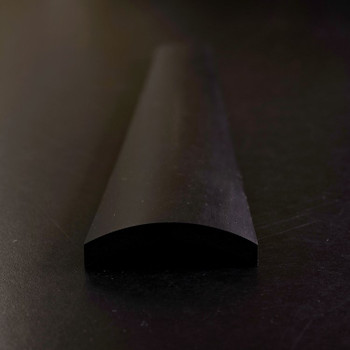Gollihur Music
Stick-on Fingerboard Markers (Temporary Inlays, side dots)
We ship worldwide! (Read this)
- Small Accessory:
- This item ships FREE (USA) in a cart totaling $100 or more
Description
DON'T BUY THESE!
Wait, what?
Okay, I'm joking... maybe you might want to. I've often been asked about putting inlays on the side of fingerboards, as a visual aid to mark where the notes are. Just know that some teachers recommend against them, as they feel that using a visual crutch like side markers can actually delay your progress on the bass. The idea is to NOT use your eyes, but rather your ears - and develop your muscle memory, so your hands simply go to the right place without help from your eyes. This leaves your eyes free to read the music, connect with your bandmates, or flirt with the hottie at the table by the door.
Regardless, I do understand that sometimes folks feel more confident and comfortable with a little help nailing down the positions on the fingerboard, especially those making the transition from a smaller scale bass guitar - which usually does have handy dots on the fretboard. You also might play in a loud stage situation, or have to make large jumps up the fingerboard, and want the confidence to know that you'll land in the right place. No judgment from me, folks.
And of course, these would be useful - even for a seasoned player - if you're playing in a "room from hell" where you can't hear yourself well enough to judge your intonation; the visual reinforcement would certainly be helpful in that case!
Regardless, I always recommend NOT doing something permanent, like real inlays. For one thing, it could hurt your bass' resale value... and you eventually will develop your ear, at which point you won't want the markers anymore. But if they're permanent... Oops!
Anyway, here's the alternative, which is wonderfully temporary. You get a total of 18 white or maple-colored vinyl stick-on "fake inlays" - 12 "dots" and 6 "lines" (see photos) You can use either one or the other, or mix and match, or use them on a couple different basses if you want. Whatever makes you happy!
And when you've grown tired of them, simply peel them off. No harm, no foul.
"Bright White" is a high-visibility set, which - especially against a dark ebony fingerboard, would be the most visible on a dark stage or in an orchestra pit. The "Warm Maple" is a bit more subtle; as you can see, it looks similar in color to the maple neck of the bass, and looks almost like a wood inlay - better if you still want the visual markers, but don't want them to be as noticeable to others. We also offer a two-pack containing one sheet of each color so you can pick and choose to your heart's content.
The photos illustrate the vinyl dots and lines alternated in a couple of different patterns on our Estle Louis laminated basses. They are just possible arrangements; you can also go "all dots," "all lines," or any of a huge number of other variations.
The custom-cut vinyl stickers arrive in a nice re-closable bag with an insert card with instructions, and includes 12 dots and 6 rounded lines. This should be enough to do 2-3 basses! You have 18 individual stickers to draw from - be creative!
Suitable for use on upright basses of all sizes (3/4, 4/4, 1/2, 1/4, etc.) as well as all electric upright basses.
Dimensions: Dots are approximately 3/16" in diameter, lines are approximately 3/16" tall by 3/8" long. Proudly crafted and packaged in the USA, right here at Gollihur Music Galactic Headquarters.
Instructions
Installation Tips:
- They're simple stickers. Peel and stick! Try not to contact the sticky side with your fingers, the oils in your skin will make them less sticky.
- The easiest way to place them accurately is by using an electronic tuner; make sure the open string is in tune, then finger the notes you wish to mark. Adjust your finger until you have the note perfectly in tune, then apply the sticker there.
- There are also sites which host "fretboard calculators" which you can also use to measure out where the markers go - but you'll need to measure your scale length to use them - and the tuner method, above, is easier.
- I recommend placing only on the side of the fingerboard (as shown) - putting them on the face of the fingerboard, bass-guitar-style, will get you funny looks from other bassists and musicians.
- Stickers peel off with little or no residue; if they leave anything behind, a little lemon oil should remove it (and not damage your fingerboard.)
11 Reviews
-
Stick-on Fingerboard Markers
These are super handy, especially as a beginner. Nice clean look, good adhesive that stays put but doesn't leave residue, quick shipping.
-
Stick on, peel off
I got these because my bass likes gut strings better than steel - less tension makes it sound better. Raising the height of the strings seemed to make the finger placement just a bit different. I'll use these until I get the feel back. Thanks!
-
An Elegant Solution
As someone relatively new to bass (transitioning from cello), I’m still building muscle memory to find the different positions. Before, I used black finger marker tape like you’d see on beginner violins. While it worked, having it on the side still looked pretty tacky. These dots, especially the warm maple ones, blend in so seamlessly that they look like they’re part of the fingerboard. I only used the small round dots for 1st, 3rd, 4th, and the octave positions, so I have some extras left over. They’ve been brilliant for helping me play more confidently in tune, especially in a loud orchestra setting where it’s hard to hear myself. As I build my muscle memory, these dots give me the visual aid I need without compromising the aesthetic of the instrument. Highly recommended for anyone learning bass or looking for a more subtle solution! I put them on by tuning, using the tuner to find the right position, and then using tweezers to place the dot. It's helpful if you have a friend, but you can do it on your own. These are so brilliant.
-
I always keep a set on hand
I play fretless basses, electric uprights and uprights. The one thing I find is a lack of any indication of the first fret...so I place a sticker on every instrument...if you ever need to remove them, no residue.
-
Helpful item
A helpful aid for lots of situations. Beginning players, playing loud venues, etc. Their appearance is discrete and they do not leave any sticky residue.















